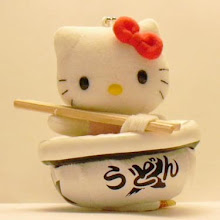Spring Fever
Ah yes, my vacation has finally arrived. Now I can indulge in my Kitty habits!
Spring sprang up a few months ago and if I'm not careful, summer will be in full steam before I've introduced the regional kitties that signify spring and along with it, the wonderful affliction of "spring fever." Here are a few of those traditional flowers of spring as well as the kitties that remind me of the sleepiness and the restlessness that comes with it.
HIROSAKI SAKURA MATSURI
Aomori Prefecture
Tohoku, Japan

Kitty rides a scattering sakura or cherry blossom that gently falls from one of the thousands of cherry trees that surround the medevial Hirosaki Castle. These beautiful flowers are in bloom for only a week so there is a lot of attention paid to "blossom forecast" or sakurazensen. In the "old days" the blossoms were used to indicate the time for rice-planting and to fortell the season's harvest. The aristocrats of the Heian days were a little more philosophical about the flowers, seeing them as a metaphor for the ephemeralness of beauty and life. Viewing these blossoms (or hanami) is still carried out today with special trips to popular areas such as Hirosaki Castle.
DAZAIFU UME
Fukuoka prefecture
Kyushu, Japan

Kitty poses as "the other" flower of spring; the ume or plum blossom. It is believed that the plum tree was introduced to Japan by the Chinese along with their tradition of hanami. In Dazaifu, the plum tree has special meaning. The famous Heian scholar and politician, Sugawara Michizane was exiled from Kyoto to Dazaifu after being falsely accused of treason. Legend says that when he was exiled, a plum tree is said to have followed him by flying from Kyoto to Dazaifu. Today, the flying plum tree or tobiume stands to the right of the front hall entrance of Dazaifu Tenmagu - one of the most important shrines built and dedicated to Sugawara Michizane.
MIZUBASHO MARSH LILY
Gunma prefecture
Kanto, Japan

Like her plum sister, Kitty looks reluctant to deal with spring and is perfectly happy to stay cloister in her tightly closed, yet cosy blossom. In the case of the mizubasho or (hang on to your noses) skunk cabbage, I'd be reluctant to step out of the blossom bud as well. The mizubasho, a lily like plant begins to sprout in the marshland bogs of Oze when the snow begins to melt. They say that May is the best time to see them in their full glory. Unlike her American counterpart, the japanese skunk cabbage doesn't smell.
Spring sprang up a few months ago and if I'm not careful, summer will be in full steam before I've introduced the regional kitties that signify spring and along with it, the wonderful affliction of "spring fever." Here are a few of those traditional flowers of spring as well as the kitties that remind me of the sleepiness and the restlessness that comes with it.
HIROSAKI SAKURA MATSURI
Aomori Prefecture
Tohoku, Japan

Kitty rides a scattering sakura or cherry blossom that gently falls from one of the thousands of cherry trees that surround the medevial Hirosaki Castle. These beautiful flowers are in bloom for only a week so there is a lot of attention paid to "blossom forecast" or sakurazensen. In the "old days" the blossoms were used to indicate the time for rice-planting and to fortell the season's harvest. The aristocrats of the Heian days were a little more philosophical about the flowers, seeing them as a metaphor for the ephemeralness of beauty and life. Viewing these blossoms (or hanami) is still carried out today with special trips to popular areas such as Hirosaki Castle.
DAZAIFU UME
Fukuoka prefecture
Kyushu, Japan

Kitty poses as "the other" flower of spring; the ume or plum blossom. It is believed that the plum tree was introduced to Japan by the Chinese along with their tradition of hanami. In Dazaifu, the plum tree has special meaning. The famous Heian scholar and politician, Sugawara Michizane was exiled from Kyoto to Dazaifu after being falsely accused of treason. Legend says that when he was exiled, a plum tree is said to have followed him by flying from Kyoto to Dazaifu. Today, the flying plum tree or tobiume stands to the right of the front hall entrance of Dazaifu Tenmagu - one of the most important shrines built and dedicated to Sugawara Michizane.
MIZUBASHO MARSH LILY
Gunma prefecture
Kanto, Japan

Like her plum sister, Kitty looks reluctant to deal with spring and is perfectly happy to stay cloister in her tightly closed, yet cosy blossom. In the case of the mizubasho or (hang on to your noses) skunk cabbage, I'd be reluctant to step out of the blossom bud as well. The mizubasho, a lily like plant begins to sprout in the marshland bogs of Oze when the snow begins to melt. They say that May is the best time to see them in their full glory. Unlike her American counterpart, the japanese skunk cabbage doesn't smell.


1 Comments:
Kawaii ^_^
Post a Comment
<< Home